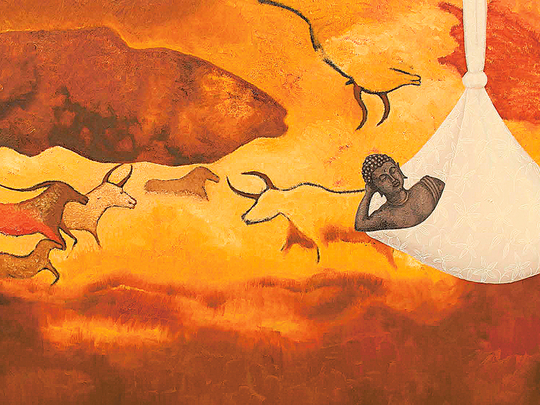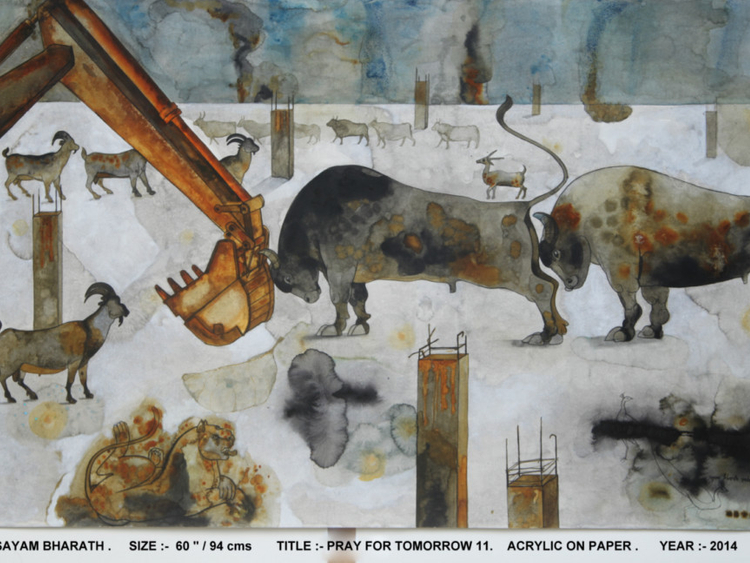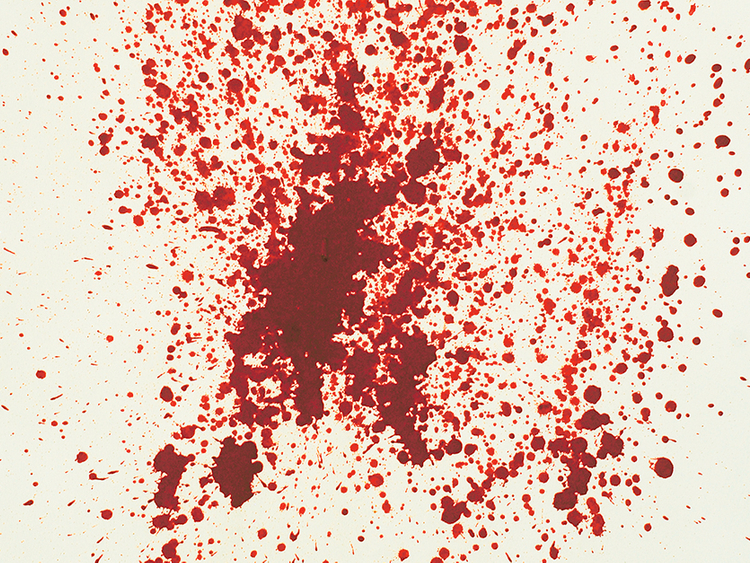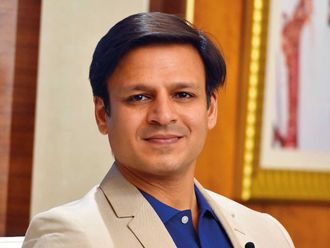
The latest exhibition at Art*ry Dubai, “NH 7 + 47: Southern Sojourn” goes beyond the main Indian art centres of Mumbai, Vadodara, Delhi and Kolkata to present a refreshingly different facet of contemporary Indian art. Curator Mukta Ahluwalia Bedi set out on a road trip across the southern Indian states of Telangana, Tamil Nadu and Kerala to seek out artists living and working away from the mainstream metropolitan arts scene.
The title of the show refers to the national highways along which Bedi travelled to visit the artists in their studios on the outskirts of cities and in small towns and villages.
“My aim was to introduce new talent from India and new works that are fun, fresh and exciting to this region, and to provide an opportunity for alternative art practices to emerge and grow. These artists are among the rising stars of contemporary Indian art and many have won awards for their work. This show offers them the opportunity to connect with a wider audience. It is the first in a series of four shows I plan to do by travelling on similar journeys of discovery in other parts of India,” Bedi says.
The 17 artists featured in the show have diverse vocabularies and art practices, but their work reflects a non-urban socio-cultural milieu and a connection to tradition and nature that is often missing in urban art. Since their work is not influenced by the demands of galleries and the art market, or by urban concerns and international discourse, the artists have freely experimented with unusual media and techniques, and focused on themes that may not be trendy but are meaningful in the context of their own environment and way of life.
For example, Sayam Bharath Yadav’s main subject is buffaloes. His realistic paintings of buffaloes, bedecked with garlands and body paint, depict the annual buffalo carnival celebrated by the cowherd community of Telangana to which he belongs. In other paintings, the artist has depicted buffaloes attacking a crane on a construction site, and a group of buffaloes dressed as high society folk socialising in a well-appointed drawing room.
The works comment on the impact of urbanisation and the sale of farmland for industrial development, which has made some landowners rich while snatching away the livelihood of poor farm labourers.
Masuram Ravi Kanth draws inspiration from his memories of the atmosphere and props in his father’s photography studio. A wooden rocking horse is a recurring motif in his work, symbolising his childhood as well as the dying rocking horse industry in his village. The artist searches for his own identity through a series of photographic projections, featuring himself alongside various props in his father’s studio.
In his paintings from “The Rocking Horse” series, he deftly combines traditional and contemporary visual culture by layering images of the horse from traditional South Indian miniatures with the Greek mythology inspired logo of an international company and cheap plastic horses manufactured in China.
N. Ramachandran’s striking installation “@-07” speaks about the changing visual and material culture of contemporary India. The work is a “cabinet of curiosities” filled with traditional and modern images ranging from rural landscapes to religious and pop icons, reports and advertisements culled from mass media, and everyday objects such as traditional handicrafts, comic characters, currency notes, cassette tapes and vinyl records. Also etched on the doors of the cabinet are images from magazines and photographs.
On the other hand, Laxman Aelay’s beautiful paintings of village people from his “Song of the Village” series evoke the beauty, simplicity and leisurely pace of traditional rural life.
Many of the works are inspired by nature. In his “Accumulations” series, Saravanan Parasuraman has used tiny steel balls to recreate organic forms such as ant hills in an allegorical reference to the impact of our actions on ourselves and our planet. Sebastian Varghese explores the similarities between the backwaters of Kerala and areas of the Mississippi delta in his beautiful water and acrylic paintings on rice paper.
Gauri Vemula celebrates nature and its infinite cycles of creation, transformation and destruction through her intricate, complex pen and ink drawings of organic forms concealed within a seemingly amorphous mass. Vijay Pichumani has used collagraphy, woodcut, acrylic and watercolour to depict the lotus ponds teeming with life, in his village.
Janarthana Rudramoorthy’s “Nest” series, where the human body is represented by a nest-like iron structure that nurtures the soul within, also relates human beings to nature.
Madhu Venugopal’s paintings reflect his interest in philosophy and spirituality. A cave or womb-like cradle is a recurring motif in his work, which speaks about the cradle of humanity and art through references to the Buddha and the Altamira cave paintings.
Srinivas Reddy contemplates the origin and evolution of life and the universe through his egg-shaped, hand-painted, fibreglass sculptures from the “Swayambhu” series.
Anamika Vijayveeraraghavan’s piece “Golden Surface” is inspired by the traditional art of Tanjore paintings. Her canvas is covered with dots cut out from newspapers. The artist sees the process of pasting these dots representing different emotions, people and events as a meditative process akin to the chanting of mantras.
Rohini Reddy’s introspective pen and mixed media paintings portray the artist cocooned in an inner world infused with the vitality and creative power of nature, and her sculptures express the strength and power of women.
Priti Samyukta’s paintings combine self-portraits and words from poetry to explore her own identity in the context of cultural and historical attitudes towards women.
Some artists have used abstraction to express themselves. Shridhar Iyer captures the joy of the journey of life through the energetic, dancing strokes and vibrant colours in his “Jatra” series. Kumaresan Selvaraj’s thought-provoking abstract paintings have been created with materials of ritual ornamentation such as sandalwood powder, ash and “kumkum” powder, and Yuvan Bothisathuvar has arranged strips of paper from print-press waste on wooden board to create abstract works that change as viewers move around them. His layered works reflect the complexity of life and human relationships.
Jyoti Kalsi is an arts enthusiast based in Dubai.
“NH 7 + 47: Southern Sojourn” will run at Art*ry, Al Quoz, until June 13.















